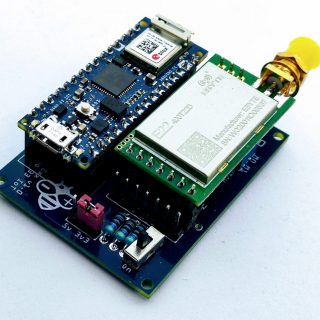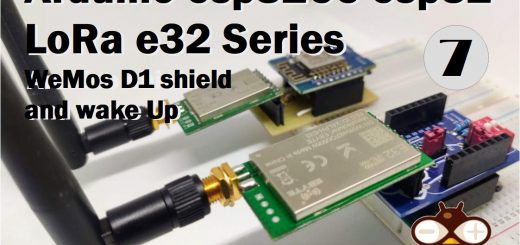Home › Forums › The libraries hosted on the site › EByte LoRa e22 UART devices sx1262/sx1268 › E22/E220 configuration
Tagged: configuration, E220
- This topic has 9 replies, 2 voices, and was last updated 3 years, 8 months ago by
Renzo Mischianti.
-
AuthorPosts
-
-
14 February 2022 at 08:48 #18627
Hello,
I’m new to this forum and I just started looking at a way to setup a point-to-point communication using E220-900T22D modules with Arduinos (or ESP32).
I’m a bit confused by some comments in the examples for fixed transmission and for receiving message as explained below:
Comments in the Arduino Fixed Transmission source :
// with this DESTINATION_ADDL 2 you must set // FIXED SENDER configuration to the other device and // FIXED RECEIVER to this device #define DESTINATION_ADDL 2Comments in the Arduino Receive Message source :
// with this RECEIVER_ADDL 3 you must set // FIXED RECEIVER configuration to the other device and // FIXED SENDER to this device #define DESTINATION_ADDL TThe way it is written it looks like the Fixed Transmission device must be configured as a FIXED RECEIVER whilst the receiver must be configured as a FIXED SENDER.
Shouldn’t that be the other way around?
-
14 February 2022 at 09:23 #18629
Hi Robert,
Welcome to the forum, I think you get the library from
Ebyte E220 (LLCC68) compatibility
And the example from the same topic.You need another sketch to understand that comments. I created a setConfiguration file with a long set of configuration examples to simplify your work, and I named every configuration like FIXED SENDER or FIXED RECEIVER.
I have attached the setConfiguration file.
I will release the complete library and tutorial soon.
Bye Renzo
Attachments:
You must be logged in to view attached files. -
14 February 2022 at 10:09 #18631
Hi Renzo,
Thanks for your fast reply!
In fact I got the complete library and examples from github and I already looked at the setConfiguration file. You did a great job! It will surely simplify my work. Thanks a lot.
However, what I don’t understand is that in the fixed transmission file (Arduino_e22_04_SendFixedTransmission.ino) there is a comment saying that the the other device (i.e. the receiver of the fixed transmission) should be set as a FIXED SENDER and this device (i.e. the fixed sender) should be set as FIXED RECEIVER.
I would expect it to be just the other way around.
Same comment for the receive message file (Arduino_e22_08_receiveMessage.ino) where the configurations are reversed and saying that this device (i.e. the receiver) should be configured as a FIXED SENDER.
Am I missing something?
Best regards,
Robert -
14 February 2022 at 10:30 #18632
Hi Robert,
pay attention, you have an E220 and you download from GitHub the library for E22.You must use the same example Arduino_e22_04_SendFixedTransmission for the sender and for the receiver.
But the sender needs FIXED SENDER configuration, and you must uncomment the lines
// With FIXED SENDER configuration #define DESTINATION_ADDL 3and a receiver (same as the sender but) you must set FIXED RECEIVER and uncomment the lines
// With FIXED RECEIVER configuration #define DESTINATION_ADDL 2Bye Renzo.
-
14 February 2022 at 11:03 #18634
Hi Renzo,
Thank you very much. It’s clear now.
I am aware that the library is for the E22 series but I think it can be used with the E220 in my case as I only need a simple point-to-point fixed TX/RX link.
Maximum packet size of 200 is OK for me and I don’t need a network ID.
One major difference is that M1 & M0 both need to be “1” for configuring the device instead of “1” and “0” respectively for the E22 series.
I still need to check if there are other differences in the various registers bit settings.
Bye,
Robert -
14 February 2022 at 11:30 #18635
Hi Robert,
you can download the E220 library (beta for now, but fully working) from this topic reply.The code is pretty equal to the E22 examples.
Bye Renzo
-
14 February 2022 at 11:52 #18636
Hi Renzo,
Thanks you for the link. I wasn’t aware that you already released the E220 library.
Bye,
Robert -
25 February 2022 at 08:45 #18917
Hi Renzo,
I came across a discrepancy in the comments in the the E220 example file 01_setConfiguration.ino
The pin assignments for an Arduino Nano in the top of the comments do not match the pin assignments in the lines below that can be uncommented. See attached screen capture.I presume that for an Arduino Nano I/O pins 6, 2 & 4 are used for AUX, M0 & M1 respectively in your library, right?
By the way, I presume I can use other I/O pins if it simplifies the PCB routing and change my source file accordingly, right?
Best regards and thanks for your help.
Robert
Attachments:
You must be logged in to view attached files. -
25 February 2022 at 10:44 #18921
-
12 March 2022 at 19:25 #19576
The Library for E220 is released. You can find it from library manager and GitHub.
Bye Renzo
-
-
AuthorPosts
- You must be logged in to reply to this topic.







